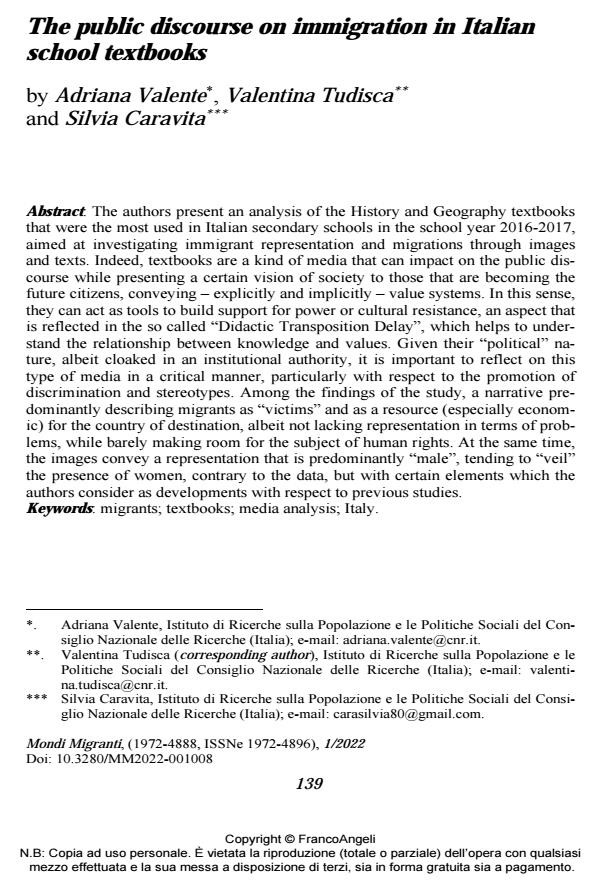The public discourse on immigration in Italian school textbooks
Titolo Rivista MONDI MIGRANTI
Autori/Curatori Adriana Valente, Valentina Tudisca, Silvia Caravita
Anno di pubblicazione 2022 Fascicolo 2022/1
Lingua Inglese Numero pagine 19 P. 139-157 Dimensione file 287 KB
DOI 10.3280/MM2022-001008
Il DOI è il codice a barre della proprietà intellettuale: per saperne di più
clicca qui
Qui sotto puoi vedere in anteprima la prima pagina di questo articolo.
Se questo articolo ti interessa, lo puoi acquistare (e scaricare in formato pdf) seguendo le facili indicazioni per acquistare il download credit. Acquista Download Credits per scaricare questo Articolo in formato PDF

FrancoAngeli è membro della Publishers International Linking Association, Inc (PILA)associazione indipendente e non profit per facilitare (attraverso i servizi tecnologici implementati da CrossRef.org) l’accesso degli studiosi ai contenuti digitali nelle pubblicazioni professionali e scientifiche
The authors present an analysis of the History and Geography textbooks that were the most used in Italian secondary schools in the school year 2016-2017, aimed at investigating immigrant representation and migrations through images and texts. Indeed, textbooks are a kind of media that can impact on the public discourse while presenting a certain vision of society to those that are becoming the future citizens, conveying - explicitly and implicitly - value systems. In this sense, they can act as tools to build support for power or cultural resistance, an aspect that is reflected in the so called "Didactic Transposition Delay", which helps to understand the relationship between knowledge and values. Given their "political" nature, albeit cloaked in an institutional authority, it is important to reflect on this type of media in a critical manner, particularly with respect to the promotion of discrimination and stereotypes. Among the findings of the study, a narrative predominantly describing migrants as "victims" and as a resource (especially eco-nomic) for the country of destination, albeit not lacking representation in terms of problems, while barely making room for the subject of human rights. At the same time, the images convey a representation that is predominantly "male", tending to "veil" the presence of women, contrary to the data, but with certain elements which the authors consider as developments with respect to previous studies.
Le autrici presentano un’analisi dei manuali di Storia e Geografia più adottati nelle scuole secondarie italiane nell’anno scolastico 2016-2017 mirata a indagare la rappresentazione di migranti e migrazioni attraverso immagini e testi. I libri di testo sono infatti un tipo di media che può incidere sul discorso pubblico nel presentare una determinata visione di società a coloro che saranno i futuri cittadini, veicolando sistemi di valori in modo esplicito e implicito. In questo senso, possono porsi come strumenti di costruzione di sostegno al potere o di resistenza culturale, un aspetto che si riflette nel cosiddetto "ritardo nella trasposizione didattica", che aiuta a comprendere la relazione tra conoscenze e valori. Dato il loro carattere "politico", seppure ammantato di un’autorità istituzionale, è rilevante riflettere su questo tipo di media in modo critico, in particolare rispetto alla promozione di discriminazioni e stereotipi. Tra i risultati emersi dallo studio, una narrazione che descrive i migranti prevalentemente come "vittime" e come risorsa (soprattutto economica) per il paese di destinazione, pur non mancando una rappresentazione in termini di problema, mentre difficilmente si lascia spazio al tema dei diritti umani. Allo stesso tempo, le immagini veicolano una rappresentazione prevalentemente "al maschile" che tende a "velare" la presenza delle donne, in contrasto con i dati, ma con alcuni elementi che le autrici considerano di evoluzione rispetto a studi precedenti.
Parole chiave:migranti; libri di testo; analisi dei media; Italia.
- Visioni di Europa e fiducia nella scienza della comunità studentesca italiana Valentina Tudisca, Nicolò Marchesini, Adriana Valente, in WELFARE E ERGONOMIA 2/2024 pp.173
DOI: 10.3280/WE2023-002012 - Silencing Refugees’ Voices in Educational Practices Valentina Tudisca, Adriana Valente, pp.79 (ISBN:978-3-031-73517-2)
Adriana Valente, Valentina Tudisca, Silvia Caravita, The public discourse on immigration in Italian school textbooks in "MONDI MIGRANTI" 1/2022, pp 139-157, DOI: 10.3280/MM2022-001008